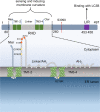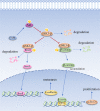Critical roles of FAM134B in ER-phagy and diseases
- PMID: 33199694
- PMCID: PMC7670425
- DOI: 10.1038/s41419-020-03195-1
Critical roles of FAM134B in ER-phagy and diseases
Abstract
FAM134B (also called JK-1, RETREG1), a member of the family with sequence similarity 134, was originally discovered as an oncogene in esophageal squamous cell carcinoma. However, its most famous function is that of an ER-phagy-regulating receptor. Over the decades, the powerful biological functions of FAM134B were gradually revealed. Overwhelming evidence indicates that its dysfunction is related to pathophysiological processes such as neuropathy, viral replication, inflammation, and cancer. This review describes the biological functions of FAM134B, focusing on its role in ER-phagy. In addition, we summarize the diseases in which it is involved and review the underlying mechanisms.
Conflict of interest statement
The authors declare that they have no conflict of interest.
Figures




References
-
- Tang JC, Lam KY, Law S, Wong J, Srivastava G. Detection of genetic alterations in esophageal squamous cell carcinomas and adjacent normal epithelia by comparative DNA fingerprinting using inter-simple sequence repeat PCR. Clin. Cancer Res. 2001;7:1539–1545. - PubMed
Publication types
MeSH terms
Substances
LinkOut - more resources
Full Text Sources
Medical

